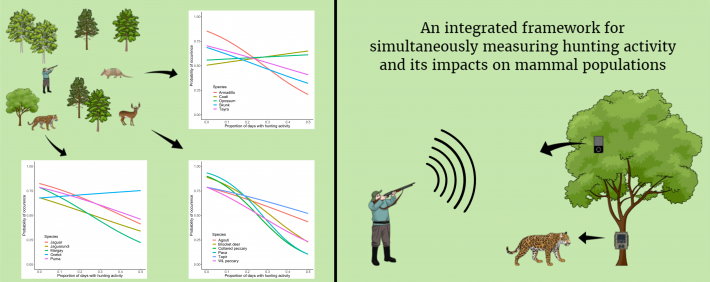Caught on tape: UF wildlife researchers repurpose listening device to track poaching
University of Florida press release.
Acoustic monitoring technologies can detect far more hunting in protected forests than cameras are able to, according to research by the University of Florida and published in Journal of Applied Ecology.

If a poacher shoots a deer in the forest and no one sees it, did it really happen?
That is not so much a philosophical question as it is a practical one for wildlife managers whose job is to conserve wildlife in protected forests around the world where unsustainable hunting can drastically reduce animal populations. Even cameras installed on trees can only capture a portion of the total hunting activity in an area.
But researchers with the University of Florida may have found one solution. In a new study conducted in four protected areas in southern Belize, researchers showed that acoustic monitoring technologies detected far more instances of hunting than cameras did. In fact, compared to acoustic monitors, cameras underestimated hunting activity by more than 900%.
Acoustic monitoring could give wildlife officials a more accurate picture of where hunting is concentrated than they’ve ever had before, said Michael Dobbins, who completed the research as part of his doctoral work in the UF/IFAS College of Agricultural and Life Sciences under the direction of Eben Broadbent, an associate professor in the UF/IFAS School of Forest Resources and Conservation. Dobbins is now a postdoctoral researcher at University of California, Davis.
“Hunting has been extremely difficult to measure through traditional means, such as ranger patrols, interviews with residents, and even camera traps,” Dobbins said. “So, we used acoustic monitors, which are typically used to monitor birds and bats, to instead monitor gunshots as a proxy for hunting activity.”
Researchers installed 25 acoustic monitors up in trees, where they recorded sound 24 hours a day. The researchers used special machine learning software to parse the sound of gunfire from ambient noise in the recordings. Gunshots recorded in the same area within a one-hour time period were considered a single instance of hunting.
“With this approach, we were able to map the distribution and frequency of hunting activity in near real-time with high precision and accuracy,” Dobbins said.
Dobbins and his team also set up 45 cameras in the same areas where the acoustic monitors were installed. This allowed them to compare how each technology detected hunting activity. The cameras also allowed the researchers to document local wildlife and correlate local hunting activity with the occurrence and diversity of mammals in the area.
Species caught on camera included many examples of wildlife native to Central American rainforests, such as jaguars, brocket deer, collared peccaries (a pig-like mammal), margays (a small wild cat) and tapirs, to name a few.
The study found that areas where hunting was more common had decreased mammal diversity, potentially due to a combination of overhunting and spatial avoidance.
While the cameras were able to document the different kinds animals passing through a given area, the acoustic monitors were far better at detecting hunting activity.
This discrepancy is due in part to the fact that cameras can only record what’s happening within their short 120-degree field of vision. The acoustic monitors, on the other hand, can detect the sounds of hunting anywhere within a 1.25-kilometer radius, the study’s authors said.
Where hunting occurs and its impact on local species is important for several reasons, Dobbins said.
“First, we can better understand mammal responses to hunting at the species and community level. Second, we can accurately in real-time assess human hunting activity over large areas to help protected areas and ranger teams combat illegal hunting. And third, we can use the information gained to guide conservation management and policy decision making,” he explained.
You can read the full article for free (for a limited time) here:
https://besjournals.onlinelibrary.wiley.com/doi/10.1111/1365-2664.13750
Media contact:
Samantha Murray, grenrosa@ufl.edu, 949-735-1076
Like what we stand for?
Support our mission and help develop the next generation of ecologists by donating to the British Ecological Society.